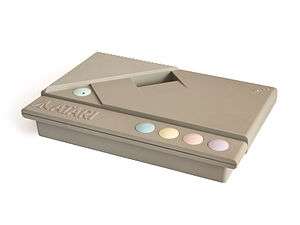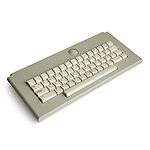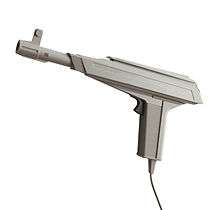Atari XEGS
 Atari XEGS | |
| Manufacturer | Atari Corporation |
|---|---|
| Type | Home video game console/personal computer/gaming PC |
| Generation | Third generation (8-bit era) |
| Release date | Fall 1987 |
| Introductory price | US$159 (equivalent to $342.50 in 2017)[1] |
| Discontinued | 1992[2] |
| Media | ROM cartridge |
| CPU | MOS Technology 6502C |
| Memory | 64KB RAM |
| Display | 384 x 240 (overscan) 256 color palette |
| Backward compatibility | Atari 8-bit computers |
| Predecessor | Atari 7800 |
| Successor | Atari Panther (cancelled) |
The Atari XE Video Game System (Atari XEGS) is a home video game console released by Atari Corporation in 1987. Based on Atari's 8-bit 65XE computer, the XEGS is compatible with the existing Atari 8-bit computer software library. Additionally, it is able to operate as either a stand-alone console or full computer with the addition of its specially designed keyboard. In computer mode, it may utilize the majority of peripherals released for Atari's 8-bit computer line. Atari packaged the XEGS as a basic set consisting of only the console and joystick, and as a deluxe set consisting of the console, keyboard, joystick and light gun.
The XEGS was supported by new titles, such as Barnyard Blaster and Bug Hunt, plus cartridge ports of older games, such as Fight Night (Accolade, 1985), Lode Runner (Brøderbund, 1983), Necromancer (Synapse Software, 1982), and Ballblazer (Lucasfilm Games, 1985).
History
John J. Anderson of Creative Computing stated in 1984, when Atari, Inc. had great financial difficulties as a division of Warner Communications, that it could and should have released a new videogame console in 1981 based on its 8-bit computers and compatible with its software library. The company instead released the incompatible Atari 5200.[3] After Jack Tramiel purchased the company, Atari Corp. re-released two game consoles in 1986: the Atari 7800, which had previously been released in a brief test run in 1984; and the Atari 2600 Jr., an updated version of the Atari VCS/2600. The XEGS followed, building on Atari's 8-bit computer line which had started with the Atari 400 and 800.[4] In practice the XEGS is a repackaged Atari 65XE, is compatible with the existing range of Atari 8-bit computer software and peripherals, and thus could function as a home computer.[5]
Atari conceived the console in a plan to increase the company's console market share while improving sales of its 8-bit home computer family. Providing a "beginning computer" and "sophisticated game console" in one device, was thought to convince more retailers and software developers to support the platform. In May 1987, Atari's then Director of Communications, Neil Harris, updated the online Atari community by outlining this plan. It noted that the XEGS was intended to further the 8-bit line by providing mass-merchants with a device that was more appealing to their markets.[6]
The system co-existed with the Atari 7800 and remodeled Atari 2600 on store shelves[1] and was occasionally featured alongside those systems in Atari print ads and television commercials.[7]
Games
The XEGS shipped with the Atari 8-bit version of Missile Command built in,[5] Flight Simulator II bundled with the keyboard component, and Bug Hunt which is compatible with the light gun. As the XEGS is compatible with the earlier 8-bit software, many games released under the XEGS banner were simply older games rebadged. This was done to the extent that some games were shipped in the old Atari 400/800 packaging, bearing only a new sticker to indicate that they were also compatible with the XEGS.[4]
Reception
Atari sold 100,000 XE Game Systems during the Christmas season in 1987, every unit that was produced during its launch window.[8]
Peripherals
The XEGS was released in a basic set and a deluxe set. The basic set includes only the console and a standard CX40 joystick (albeit with a grey base to match the XEGS, rather than the original black). The deluxe set consists of the console, the CX40 joystick, a keyboard which enables home computer functionality, and the XG-1 light gun. The keyboard and light gun peripherals were also released separately outside North America.[9] This is the first light gun produced by Atari, and it is also compatible with the Atari 7800 and Atari 2600.[5][10]
In addition, the XEGS can use the standard Atari 8-bit peripherals, allowing the use of devices such as disk drives, modems and printers.[5]

.jpg)

See also
References
- 1 2 "Kaybee Toy Store Ad". Hutchinson News. Hutchinson, Kansas. October 8, 1987. p. 64.
- ↑ "The Atari 1200XL Computer".
- ↑ Anderson, John J. (March 1984). "Atari". Creative Computing. p. 51. Retrieved February 6, 2015.
The games division [..] saw the home computer division as a threat [..] If any of their new machines could expand into true computers, the reins would automatically be handed over [..] To the games division, this was a fate worse than death [so] they chose death. [The 5200 was internally] very nearly an Atari 800 [but] all compatibility and expandability had been designed out [..] If, in 1981, the next-generation game machine had been designed to be compatible with the Atari 400 and 800 microcomputers, Atari would not be in the state it is today. Instead, the 5200 game unit was launched. Internally, it was very nearly an Atari 800, and as such was a fabulous game machine.The notable exceptions were that all compatibility and expandability had been designed out [..] with an external keyboard and 800 compatibility, could have been transformed into a product superior to the famed Coleco Adam, way back in 1982.
- 1 2 Wolf, Mark J. P. (2008). The video game explosion: a history from PONG to PlayStation and beyond. Greenwood Publishing Group. p. 60. ISBN 978-0-313-33868-7.
- 1 2 3 4 "Atari 8 Bit Computers - 1979-1987". Classic Gaming. Archived from the original on February 11, 2012. Retrieved July 21, 2010.
- ↑ Harris, Neil (May 12, 1987). "Re: Is Atari killing the 8 bit?". Retrieved August 4, 2013.
- ↑ "Atari Retailer Rebate Ad". Syracuse Herald Journal. Syracuse, New York. December 11, 1988. p. 187.
- ↑ http://www.atarimagazines.com/v7n1/marketplace.html
- ↑ "Rhod's Collection". Retrieved 2010-08-24The site links to pictures of separate XEGS packages.
- ↑ Herman, Leonard; Horwitz, Jer; Kent, Steve; Miller, Skyler. "Video Games Are Back 1985-1988". The History of Video Games. GameSpot. Archived from the original on November 18, 2012. Retrieved March 16, 2014.
| Wikimedia Commons has media related to Atari XEGS. |